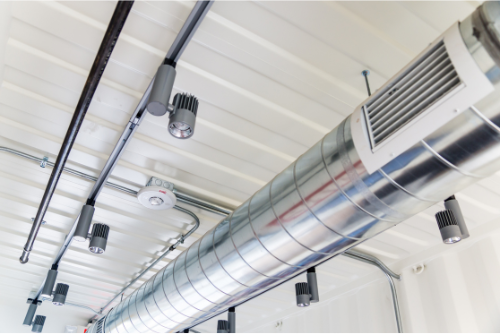If you are familiar with thermal barrier coatings, then you likely know that they benefit many different industries in various ways. However, have you ever stopped to consider the specific benefits that thermal barrier coatings offer to ductwork?
If you answered no to that question. In this article, we’ll outline five of the most prominent advantages of applying thermal barrier coatings to ductwork and share the top provider of thermal barrier coating products.
Greater Energy Efficiency
 Thermal barrier coatings can greatly improve the energy efficiency of ductwork in several ways. First, by acting as insulation, the coatings reduce heat transfer through the duct walls. This keeps more of the hot or cold air inside the ducts rather than letting it dissipate into unused spaces.
Thermal barrier coatings can greatly improve the energy efficiency of ductwork in several ways. First, by acting as insulation, the coatings reduce heat transfer through the duct walls. This keeps more of the hot or cold air inside the ducts rather than letting it dissipate into unused spaces.
Additionally, thermal barrier coatings lower the duct surface temperatures, reducing radiant heat gain or loss. This allows the ducts to maintain the supply air temperature better, without having to work as hard to compensate for heat gain or loss through the duct walls.
Altogether, estimating up to 15% or greater HVAC energy savings is reasonable with a high-quality thermal barrier coating applied to ductwork. The improved insulation, lower duct surface temps, maintained duct integrity and air sealing prevent energy losses – allowing your HVAC system to operate much more efficiently long-term.
Mitigation of Extreme Temperatures
One of the greatest benefits of applying a thermal barrier coating to ductwork is that it will help mitigate extreme temperature changes. Your ducts are responsible for transporting both hot and cold air based on the current needs of your building. That variety of temperatures can have an effect on the ductwork itself, but stress on your ductwork becomes more prevalent when the weather outside becomes excessively frigid or scorching.
For example, in the summer months, it becomes increasingly difficult for your ducts to convey cool air in spite of the high temperatures outside. The more of an impact those outside temperatures have, the greater the stress on the ducts will be. This stress causes your HVAC system to work harder than it needs to while also wearing down the materials that comprise your ducts.
Thermal barrier coatings act as a protective barrier that reduces heat transfer and limits the negative effect that outside air can have. This benefit is present in both winter and summer and helps your ducts heat and cool your building with greater efficiency and less effort.
Reduced Corrosion
Most of the components of your ductwork will consist of some type of metal. While metals tend to be durable and long-lasting, they can experience issues as well. For example, corrosion is a phenomenon that can quickly degrade the metal components of ductwork.
When corrosion occurs, it results in rust and can cause your ducts to expand beyond their normal size. Both of these issues pose a significant risk to the functionality of your HVAC system. Fortunately, one of the qualities of a thermal barrier coating is that it will protect metal surfaces from corrosion, giving them greater longevity and sustained performance over the years.
Minimized Expansion and Contraction
As temperatures rise and fall, they can cause certain materials to expand and contract. When significant expansion and contraction occur in your ductwork, it can cause components to break or lose their functionality in some other way.
Since thermal barrier coatings act as a protective barrier against extreme outside temperatures, they are the perfect option for minimizing expansion and contraction. The less your ducts expand and contract, the more likely they are to remain intact and continue to serve your building.
Less Condensation
The air and temperature changes that occur in and around your ductwork can make it more likely that condensation accumulates. Unfortunately, condensation in ductwork is far from a harmless occurrence.
Instead, excessive condensation leads to several negative outcomes, all of which you’ll want to avoid. For instance, condensation can lead to rust, deteriorating insulation, and other forms of water damage. Additionally, condensation promotes the growth of mold and mildew, which is a significant health risk, especially for those with asthma and allergies.
If you want to avoid all of those issues, then applying a thermal barrier coating is the way to go. These coatings help to seal your ducts and manage temperature changes, both of which reduce the odds that condensation will accumulate.
Greater Longevity for Ductwork Parts
Our final benefit for thermal barrier coatings for ductwork results from the previous advantages that we have already mentioned. Using a thermal barrier coating will lead to an incredible increase in the lifespan of your ducts.
Not only will thermal barrier coatings increase longevity, but they will also lead to greater operational efficiency during that prolonged lifespan. This allows your HVAC system to operate more efficiently, leading to lower energy use and long-term cost savings for you.
Get the Best Thermal Barrier Coating on the Market Today!
Not all thermal barrier coatings are equally capable of providing the benefits we listed in the article above. Instead, some products are simply more effective and preferable than others.
If you are interested in getting a thermal barrier coating for your ducts, then ThermaCote is the right choice for you. We have experience providing the best thermal barrier coatings on the market today and would love to serve you with all your thermal barrier coating needs.

